Document Outline
- FEATURES
- APPLICATIONS
- GENERAL DESCRIPTION
- FUNCTIONAL BLOCK DIAGRAM
- TABLE OF CONTENTS
- REVISION HISTORY
- ˛ˇ
- ˛ˇ
- ˛ˇ
- ˛ˇ
- ˛ˇ
- ˛ˇ
- ˛ˇ
- ˛ˇ
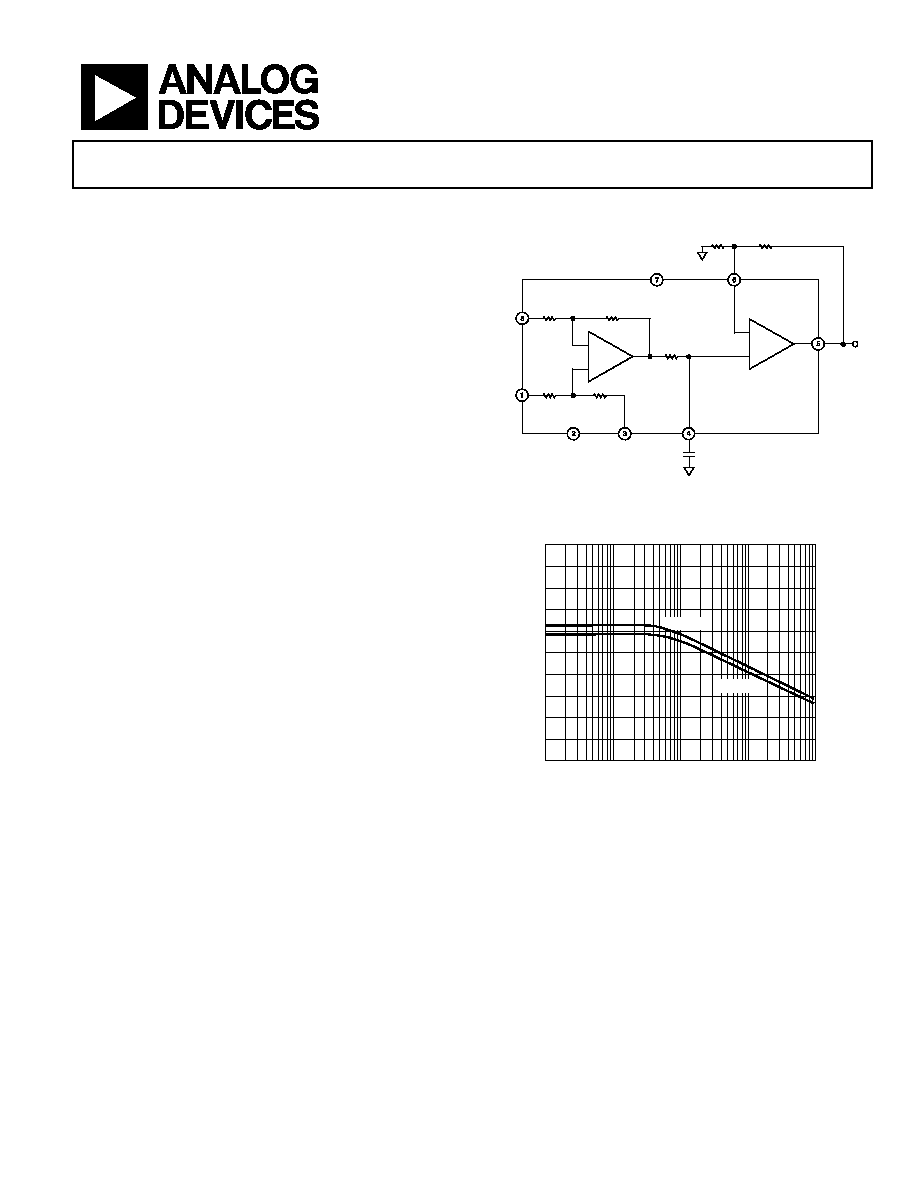
High Common-Mode Voltage
Programmable Gain Difference Amplifier
AD628
Rev. C
Information furnished by Analog Devices is believed to be accurate and reliable.
However, no responsibility is assumed by Analog Devices for its use, nor for any
infringements of patents or other rights of third parties that may result from its use.
Specifications subject to change without notice. No license is granted by implication
or otherwise under any patent or patent rights of Analog Devices. Trademarks and
registered trademarks are the property of their respective owners.
One Technology Way, P.O. Box 9106, Norwood, MA 02062-9106, U.S.A.
Tel: 781.329.4700
www.analog.com
Fax: 781.326.8703
© 2004 Analog Devices, Inc. All rights reserved.
FEATURES
High common-mode input voltage range
±120 V at V
S
= ±15 V
Gain range 0.1 to 100
Operating temperature range: -40∞C to ±85∞C
Supply voltage range
Dual supply: ±2.25 V to ±18 V
Single supply: 4.5 V to 36 V
Excellent ac and dc performance
Offset temperature stability RTI: 10 µV/∞C max
Offset: ±1.5 V mV max
CMRR RTI: 75 dB min, dc to 500 Hz, G = +1
APPLICATIONS
High voltage current shunt sensing
Programmable logic controllers
Analog input front end signal conditioning
+5 V, +10 V, ±5 V, ±10 V and 4 to 20 mA
Isolation
Sensor signal conditioning
Power supply monitoring
Electrohydraulic control
Motor control
GENERAL DESCRIPTION
The AD628 is a precision difference amplifier that combines
excellent dc performance with high common-mode rejection
over a wide range of frequencies. When used to scale high
voltages, it allows simple conversion of standard control
voltages or currents for use with single-supply ADCs. A
wideband feedback loop minimizes distortion effects due to
capacitor charging of - ADCs.
A reference pin (V
REF
) provides a dc offset for converting
bipolar to single-sided signals. The AD628 converts +5 V, +10 V,
±5 V, ±10 V, and 4 to 20 mA input signals to a single-ended
output within the input range of single-supply ADCs.
The AD628 has an input common-mode and differential
mode operating range of ±120 V. The high common-mode
input impedance makes the device well suited for high voltage
measurements across a shunt resistor. The buffer amplifier's
inverting input is available for making a remote Kelvin
connection.
FUNCTIONAL BLOCK DIAGRAM
R
EXT1
R
EXT2
R
G
+V
S
+IN
≠IN
+IN
≠IN
≠V
S
A2
A1
+IN
≠IN
100k
100k
10k
10k
V
REF
10k
AD628
OUT
G = +0.1
C
FILT
02992-C
-
001
Figure 1.
30
40
50
60
70
80
90
100
110
120
130
CMRR (dB)
FREQUENCY (Hz)
100
10
1k
10k
100k
02992-C-002
V
S
= ±2.5V
V
S
= ±15V
Figure 2. CMRR vs. Frequency of the AD628
A precision 10 k resistor connected to an external pin is
provided for either a low-pass filter or to attenuate large
differential input signals. A single capacitor implements a low-
pass filter. The AD628 operates from single and dual supplies and
is available in an 8-lead SOIC or MSOP package. It operates over
the standard industrial temperature range of -40∞C to +85∞C.

AD628
Rev. C | Page 2 of 20
TABLE OF CONTENTS
Specifications..................................................................................... 3
Absolute Maximum Ratings............................................................ 7
ESD Caution.................................................................................. 7
Pin Configuration and Function Descriptions............................. 8
Typical Performance Characteristics ............................................. 9
Test Circuits..................................................................................... 13
Theory of Operation ...................................................................... 14
Applications..................................................................................... 15
Gain Adjustment......................................................................... 15
Input Voltage Range ................................................................... 15
Voltage Level Conversion .......................................................... 16
Current Loop Receiver............................................................... 17
Monitoring Battery Voltages ..................................................... 17
Filter Capacitor Values............................................................... 18
Kelvin Connection ..................................................................... 18
Outline Dimensions ....................................................................... 19
Ordering Guide........................................................................... 19
REVISION HISTORY
4/04--Data Sheet Changed from Rev. B to Rev. C
Updated Format.................................................................Universal
Changes to Specifications............................................................... 3
Changes to Absolute Maximum Ratings ...................................... 7
Changes to Figure 3......................................................................... 7
Changes to Figure 26..................................................................... 13
Changes to Figure 27..................................................................... 13
Changes to Theory of Operation ................................................ 14
Changes to Figure 29..................................................................... 14
Changes to Table 5......................................................................... 15
Changes to Gain Adjustment Section......................................... 15
Added the Input Voltage Range Section..................................... 15
Added Figure 30 ............................................................................ 15
Added Figure 31 ............................................................................ 15
Changes to Voltage Level Conversion Section .......................... 16
Changes to Figure 32..................................................................... 16
Changes to Table 6......................................................................... 16
Changes to Figure 33 and Figure 34............................................ 17
Changes to Figure 35..................................................................... 18
Changes to Kelvin Connection Section...................................... 18
6/03--Data Sheet Changed from Rev. A to Rev. B
Changes to General Description ................................................... 1
Changes to Specifications............................................................... 2
Changes to Ordering Guide ........................................................... 4
Changes to TPCs 4, 5, and 6........................................................... 5
Changes to TPC 9............................................................................ 6
Updated Outline Dimensions...................................................... 14
1/03--Data Sheet Changed from Rev. 0 to Rev. A
Change to Ordering Guide............................................................. 4
11/02--Rev. 0: Initial Version

AD628
Rev. C | Page 3 of 20
SPECIFICATIONS
T
A
= 25∞C, V
S
= ±15 V, R
L
= 2 k, R
EXT1
= 10 k, R
EXT2
= , V
REF
= 0 unless otherwise noted.
Table 1.
AD628AR
AD628ARM
Parameter
Conditions
Min
Typ
Max
Min
Typ
Max
Unit
DIFF AMP + OUTPUT AMP
Gain Equation
G = +0.1(1+ R
EXT1
/R
EXT2
).
V/V
Gain Range
See Figure 29.
0.1
1
100
0.1
1
100
V/V
Offset Voltage
V
OCM
= 0 V. RTI of input pins
2
.
Output amp G = +1.
-1.5
+1.5
-1.5
+1.5
mV
vs. Temperature
4
8
4
8
µV/∞C
CMRR
RTI of input pins.
G = +0.1 to +100.
75
75
dB
500 Hz.
75
75
dB
Minimum CMRR Over Temperature
-40∞C to +85∞C.
70
70
dB
vs. Temperature
1
4
1
4
(µV/V)/∞C
PSRR (RTI)
V
S
= ±10 V to ±18 V.
77
94
77
94
dB
Input Voltage Range
Common Mode
-120
+120
-120
+120
V
Differential
-120
+120
-120
+120
V
Dynamic Response
Small Signal BW ≠3 dB
G = +0.1.
600
600
kHz
Full Power Bandwidth
5
5
kHz
Settling Time
G = +0.1, to 0.01%, 100 V step.
40
40
µs
Slew Rate
0.3
0.3
V/µs
Noise (RTI)
Spectral Density
1 kHz.
300
300
nV/Hz
0.1 Hz to 10 Hz.
15
15
µV p-p
DIFF-AMP
Gain
0.1
0.1
V/V
Error
-0.1
+0.01
+0.1
-0.1
+0.01
+0.1
%
vs. Temperature
5
5
ppm/∞C
Nonlinearity
5
5
ppm
vs. Temperature
3
10
3
10
ppm
Offset Voltage
RTI of input pins.
-1.5
+1.5
-1.5
+1.5
mV
vs.
Temperature
8
8
µV/∞C
Input Impedance
Differential
220
220
k
Common
Mode
55
55
k
CMRR
RTI of input pins.
G = +0.1 to +100.
75
75
dB
500 Hz.
75
75
dB
Minimum CMRR Over Temperature
-40∞C to +85∞C.
70
70
dB
vs. Temperature
1
4
1
4
(µV/V)/∞C
Output
Resistance
10
10
k
Error
-0.1
+0.1
-0.1
+0.1
%

AD628
Rev. C | Page 4 of 20
AD628AR
AD628ARM
Parameter
Conditions
Min
Typ
Max
Min
Typ
Max
Unit
OUTPUT AMPLIFIER
Gain Equation
G = (1 + R
EXT1
/R
EXT2
).
V/V
Nonlinearity
G = +1, V
OUT
= ±10 V.
0.5
0.5
ppm
Offset Voltage
RTI of output amp.
-0.15
+0.15
-0.15
+0.15
mV
vs.
Temperature
0.6
0.6
µV/∞C
Output Voltage Swing
R
L
= 10 k.
-14.2
+14.1
-14.2
+14.1
V
R
L
= 2 k.
-13.8
+13.6
-13.8
+13.6
V
Bias Current
1.5
3
1.5
3
nA
Offset Current
0.2
0.5
0.2
0.5
nA
CMRR
V
CM
= ±13 V.
130
130
dB
Open-Loop Gain
V
OUT
= ±13 V.
130
130
dB
POWER SUPPLY
Operating Range
±2.25
±18
±2.25
±18
V
Quiescent Current
1.6
1.6
mA
TEMPERATURE RANGE
≠40
+85
≠40
+85
∞C
1
To use a lower gain, see the Gain Adjustment section.
2
The addition of the difference amp's and output amp's offset voltage does not exceed this specification.

AD628
Rev. C | Page 5 of 20
T
A
= 25∞C, V
S
= +5 V, R
L
= 2 k, R
EXT1
= 10 k, R
EXT2
= , V
REF
= +2.5 unless otherwise noted.
Table 2.
AD628AR
AD628ARM
Parameter
Conditions
Min Typ Max
Min Typ Max
Unit
DIFF AMP + OUTPUT AMP
Gain Equation
G = +0.1(1+ R
EXT1
/R
EXT2
).
V/V
Gain Range
See Figure 29.
0.1
1
100
0.1
1
100
V/V
Offset Voltage
V
OCM
= 2.25 V. RTI of input pins
2
.
Output Amp G = +1.
-3.0
+3.0 -3.0
+3.0
mV
vs. Temperature
6
15
6
15
µV/∞C
CMRR
RTI of input pins. G = 0.1 to 100.
75
75
dB
500 Hz.
75
75
dB
Minimum CMRR Over Temperature
-40∞C to +85∞C.
70
70
dB
vs. Temperature
1
4
1
4
(µV/V)/∞C
PSRR (RTI)
V
S
= 4.5 V to 10 V.
77
94
77
94
dB
Input
Voltage
Range
Common Mode
3
-12
+17
-12
+17
V
Differential
-15
+15
-15
+15
V
Dynamic
Response
Small Signal BW ≠3 dB
G = +0.1.
440
440
kHz
Full Power Bandwidth
30
30
kHz
Settling Time
G = +0.1, to 0.01%, 30 V step.
15
15
µs
Slew Rate
0.3
0.3
V/µs
Noise
(RTI)
Spectral Density
1 kHz.
350
350
nV/Hz
0.1 Hz to 10 Hz.
15
15
µV p-p
DIFF-AMP
Gain
0.1
0.1
V/V
Error
≠0.1
+0.01
+0.1 ≠0.1
+0.01
+0.1
%
Nonlinearity
3
3
ppm
vs. Temperature
3
10
3
10
ppm
Offset Voltage
RTI of input pins.
-2.5
+2.5 -2.5
+2.5
mV
vs.
Temperature
10
10
µV/∞C
Input
Impedance
Differential
220
220
k
Common Mode
55
55
k
CMRR
RTI of input pins. G = +0.1 to +100.
75
75
dB
500 Hz.
75
75
dB
Minimum CMRR Over Temperature
-40∞C to +85∞C.
70
70
dB
vs. Temperature
1
4
1
4
(µV/V)/∞C
Output Resistance
10
10
k
Error
-0.1
+0.1 -0.1
+0.1
%
OUTPUT
AMPLIFIER
Gain Equation
G = (1 + R
EXT1
/R
EXT2
).
V/V
Nonlinearity
G = +1, V
OUT
= 1 V to 4 V.
0.5
0.5
ppm
Output Offset Voltage
RTI of output amp.
-0.15
0.15
-0.15
0.15
mV
vs.
Temperature
0.6
0.6
µV/∞C
Output Voltage Swing
R
L
= 10 k.
0.9
4.1
0.9
4.1
V
R
L
= 2 k.
1
4
1
4
V
Bias Current
1.5
3
1.5
3
nA
Offset Current
0.2
0.5
0.2
0.5
nA
CMRR
V
CM
= 1 V to 4 V.
130
130
dB
Open-Loop Gain
V
OUT
= 1 V to 4 V.
130
130
dB

AD628
Rev. C | Page 6 of 20
AD628AR
AD628ARM
Parameter
Conditions
Min Typ Max
Min Typ Max
Unit
POWER
SUPPLY
Operating Range
±2.25
+36
±2.25
+36
V
Quiescent Current
1.6
1.6
mA
TEMPERATURE RANGE
-40
+85
-40
+85
∞C
1
To use a lower gain, see the Gain Adjustment section.
2
The addition of the difference amp's and output amp's offset voltage does not exceed this specification.
3
Greater values of voltage are possible with greater or lesser values of V
REF
.

AD628
Rev. C | Page 7 of 20
ABSOLUTE MAXIMUM RATINGS
Table 3.
Parameter Rating
Supply Voltage
±18 V
Internal Power Dissipation
See Figure 3
Input Voltage (Common Mode)
±120 V
1
Differential Input Voltage
±120 V
1
Output Short-Circuit Duration
Indefinite
Storage Temperature
≠65∞C to +125∞C
Operating Temperature Range
≠40∞C to +85∞C
Lead Temperature Range (10 sec Soldering)
300∞C
Stresses greater than those listed under Absolute Maximum
Ratings may cause permanent damage to the device. This is a
stress rating only; functional operation of the device at these or
any other conditions above those indicated in the operational
section of this specification is not implied. Exposure to absolute
maximum rating conditions for extended periods may affect
device reliability.
1
When using ±12 V supplies or higher (see the Input Voltage Range section).
0
0.2
0.4
0.6
0.8
1.0
POW
E
R
D
ISSIPA
TION
(
W
)
1.2
1.4
1.6
20
0
≠40
≠20
≠60
40
60
80
100
AMBIENT TEMPERATURE (∞C)
02992-C-003
8-LEAD SOIC PACKAGE
8-LEAD MSOP PACKAGE
T
J
= 150∞C
MSOP
J
(JEDEC; 4-LAYER BOARD) = 132.54∞C/W
SOIC
J
(JEDEC; 4-LAYER BOARD) = 154∞C/W
Figure 3. Maximum Power Dissipation vs. Temperature
ESD CAUTION
ESD (electrostatic discharge) sensitive device. Electrostatic charges as high as 4000 V readily accumulate on
the human body and test equipment and can discharge without detection. Although this product features
proprietary ESD protection circuitry, permanent damage may occur on devices subjected to high energy
electrostatic discharges. Therefore, proper ESD precautions are recommended to avoid performance
degradation or loss of functionality.

AD628
Rev. C | Page 8 of 20
PIN CONFIGURATION AND FUNCTION DESCRIPTIONS
TOP VIEW
(Not to Scale)
8
7
6
5
1
2
3
4
+IN
≠V
S
V
REF
C
FILT
≠IN
+V
S
R
G
OUT
AD628
02992-C-004
Figure 4. Pin Configuration
Table 4. Pin Function Descriptions
Pin No.
Mnemonic
Function
1
+IN
Noninverting Input
2
-V
S
Negative Supply Voltage
3
V
REF
Reference Voltage Input
4
C
FILT
Filter Capacitor Connection
5
OUT
Amplifier Output
6
R
G
Output Amplifier Inverting Input
7
+V
S
Positive Supply Voltage
8
-IN
Inverting Input
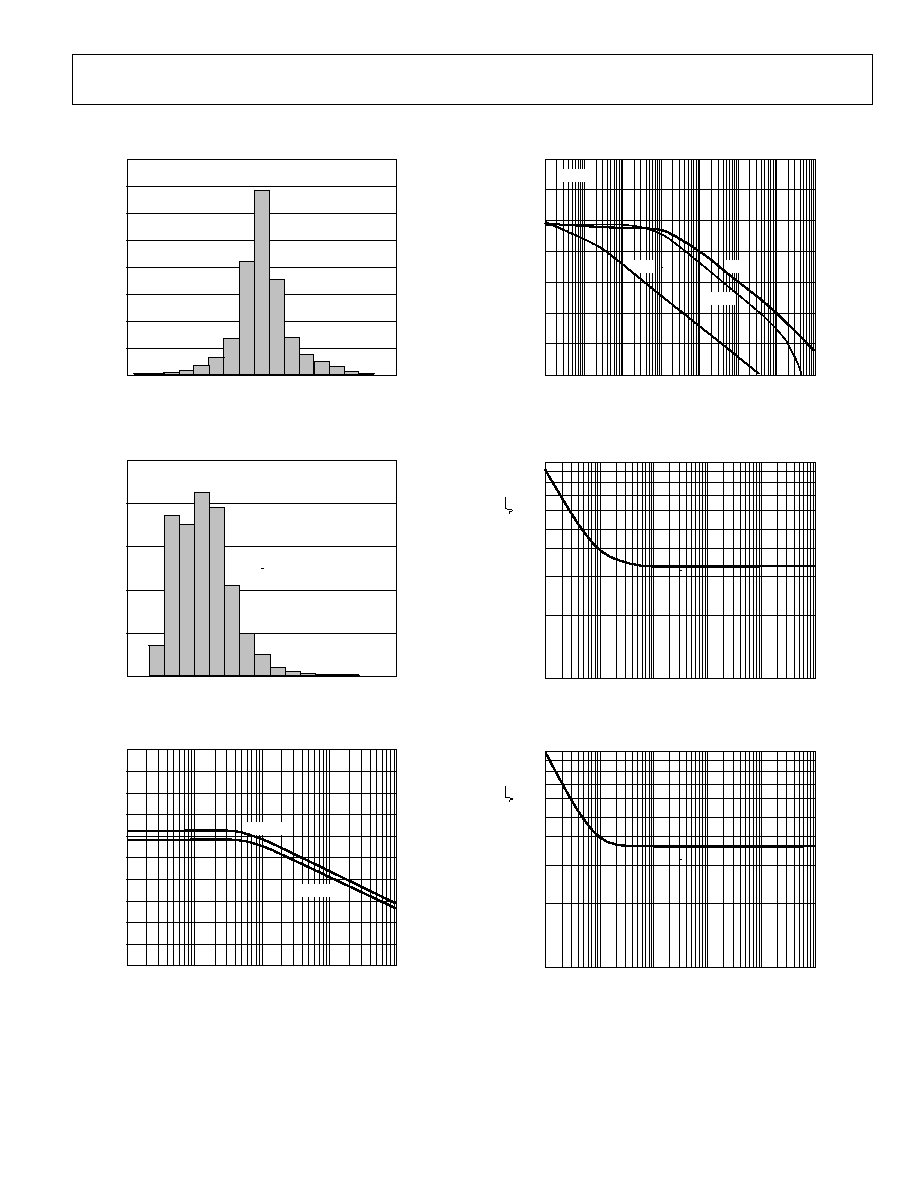
AD628
Rev. C | Page 9 of 20
TYPICAL PERFORMANCE CHARACTERISTICS
0
5
10
15
20
25
% OF UNITS
30
35
40
≠1.6
≠1.2
≠0.8
≠0.4
0
0.4
0.8
1.2
1.6
2.0
INPUT OFFSET VOLTAGE (mV)
02992-C-005
8440 UNITS
Figure 5. Typical Distribution of Input Offset Voltage,
V
S
= ±15 V, SOIC Package
0
5
10
15
20
25
% OF UNITS
≠74
≠78
≠82
≠86
≠90
≠94
≠98
≠102 ≠106 ≠110
CMRR (dB)
02992-C-006
8440 UNITS
Figure 6. Typical Distribution of Common-Mode Rejection, SOIC Package
30
40
50
60
70
80
90
100
110
120
130
CMRR (dB)
FREQUENCY (Hz)
100
10
1k
10k
100k
02992-C-007
V
S
= ±2.5V
V
S
= ±15V
Figure 7. CMRR vs. Frequency
0
20
40
60
80
100
120
140
P
S
RR (dB)
0.1
1
10
100
1k
10k
100k
1M
FREQUENCY (Hz)
02992-C-008
G = +0.1
≠15V
+15V
+2.5V
Figure 8. PSRR vs. Frequency, Single and Dual Supplies
VOLTA
GE N
OISE D
E
N
S
ITY (
n
V/ H
z
)
100
1000
1
10
100
1k
10k
100k
FREQUENCY (Hz)
02992-C-009
Figure 9. Voltage Noise Spectral Density, RTI, V
S
= ±15 V
VOLTA
GE N
OISE D
E
N
S
ITY (
n
V/ H
z
)
100
1000
1
10
100
1k
10k
100k
FREQUENCY (Hz)
02992-C-010
Figure 10. Voltage Noise Spectral Density, RTI, V
S
= ±2.5 V

AD628
Rev. C | Page 10 of 20
02992-C-011
100
90
10
0
10
TIME (Sec)
5
N
O
ISE (
5
µ
V/D
I
V)
0
1s
Figure 11. 0.1 Hz to 10 Hz Voltage Noise, RTI
≠40
≠30
≠20
≠10
0
10
20
30
40
50
60
GAIN (
d
B)
100
1k
10k
100k
1M
10M
FREQUENCY (Hz)
02992-C-012
G = +100
G = +10
G = +1
G = +0.1
Figure 12. Small Signal Frequency Response,
V
OUT
= 200 mV p-p, G = +0.1, +1, +10, and +100
≠40
≠30
≠20
≠10
0
10
20
30
40
50
60
GAIN (
d
B)
10
100
1k
10k
100k
1M
FREQUENCY (Hz)
02992-C-013
G = +100
G = +10
G = +1
G = +0.1
Figure 13. Large Signal Frequency Response,
V
OUT
= 20 V p-p, G = +0.1, +1, +10, and +100
0
5
10
15
20
25
% OF D
EVIC
E
S
30
35
40
0
1
2
3
4
5
6
7
8
9
10
GAIN ERROR (ppm)
02992-C-014
9638 UNITS
Figure 14. Typical Distribution of +1 Gain Error
≠150
≠100
≠50
0
50
100
150
COM
M
ON-
M
ODE VOLTAGE (
V
)
V
S
(±V)
5
0
10
15
20
02992-C-015
UPPER CMV LIMIT
LOWER CMV LIMIT
V
REF
= 0V
+85∞C
≠40∞C
+85∞C
≠40∞C
+25∞C
Figure 15. Common-Mode Operating Range vs.
Power Supply Voltage for Three Temperatures
02992-C-016
100
90
10
0
500
µ
V
4.0V
R
L
= 1k
R
L
= 2k
R
L
= 10k
V
S
= ±15V
OUTPUT VOLTAGE (V)
OUTP
UT E
RROR (
µ
V)
Figure 16. Normalized Gain Error vs. V
OUT
, V
S
= ±15 V

AD628
Rev. C | Page 11 of 20
02992-C-017
100
90
10
0
100
µ
V
500mV
R
L
= 1k
R
L
= 2k
R
L
= 10k
V
S
= ±2.5V
OUTPUT VOLTAGE (V)
OUTP
UT E
R
ROR (
µ
V)
Figure 17. Normalized Gain Error vs. V
OUT
, V
S
= ±2.5 V
BIAS
CURRE
NT (nA)
0
1
2
3
4
≠40
≠20
0
20
40
60
80
100
TEMPERATURE (∞C)
02992-C-018
Figure 18. Bias Current vs. Temperature Buffer
≠15
≠10
≠5
0
5
10
15
OUTPUT VOLTAGE SW
ING (
V
)
0
5
10
15
20
25
OUTPUT CURRENT (mA)
02992-C-019
≠25∞C
+85∞C
≠25∞C
≠40∞C
+25∞C
≠40∞C
+85∞C
+25∞C
Figure 19. Output Voltage Operating Range vs. Output Current
02992-C-020
100
90
10
0
500mV
50mV
4
µ
s
Figure 20. Small Signal Pulse Response,
R
L
= 2 k, C
L
= 0 pF, Top: Input, Bottom: Output
02992-C-021
100
90
10
0
500mV
50mV
4
µ
s
Figure 21. Small Signal Pulse Response,
R
L
= 2 k, C
L
= 1000 pF, Top: Input, Bottom: Output
02992-C-022
100
90
10
0
10.0 V
10.0 V
40
µ
s
Figure 22. Large Signal Pulse Response,
R
L
= 2 k, C
L
= 1000 pF, Top: Input, Bottom: Output
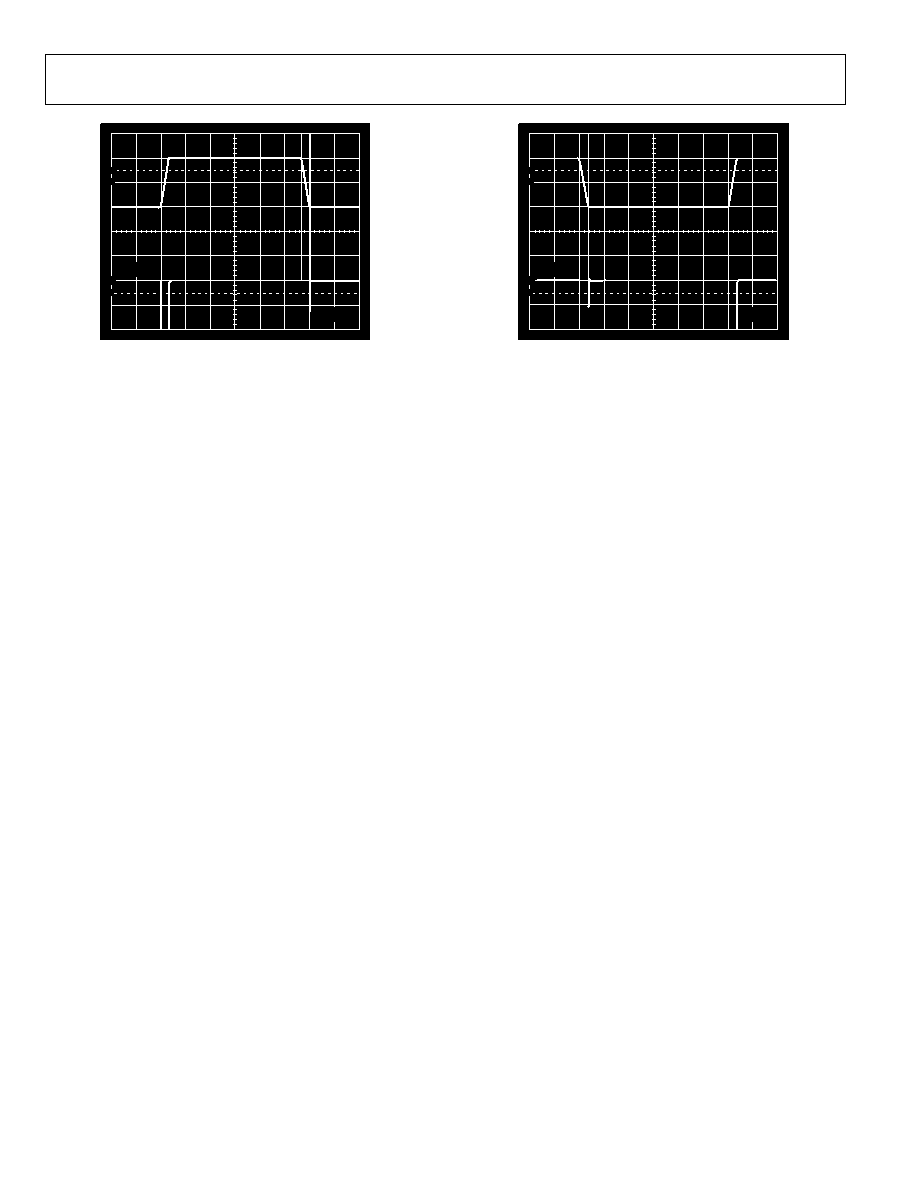
AD628
Rev. C | Page 12 of 20
02992-C-023
100
90
10
0
5V
10mV
100
µ
s
Figure 23. Settling Time to 0.01%, 0 V to 10 V Step
02992-C-024
100
90
10
0
5V
10mV
100
µ
s
Figure 24. Settling Time to 0.01% 0 V to -10 V Step

AD628
Rev. C | Page 13 of 20
TEST CIRCUITS
+IN
≠IN
OUT
+
≠
AD829
G = +100
+IN
≠IN
G = +0.1
+
≠
AD707
≠IN
+IN
100k
FET
PROBE
HP3589A
SPECTRUM ANALYZER
C
FILT
≠V
S
V
REF
100k
R
G
10k
10k
10k
AD628
+V
S
02992-
C-
025
Figure 25. CMRR vs. Frequency
+IN
100k
C
FILT
V
REF
AD628
+V
S
+IN
≠IN
OUT
≠V
S
R
G
+
≠
AD829
+IN
≠IN
G = +0.1
G = +100
G = +100
SCOPE
10k
≠IN
100k
10k
10k
20
+15V
1 VAC
02992-
C
-
026
Figure 26. PSRR vs. Frequency
6
2
3
1
8
7
5
4
+IN
100k
C
FILT
V
REF
10k
AD628
+V
S
HP3561A
SPECTRUM ANALYZER
10k
10k
+IN
≠IN
G = +0.1
+IN
≠IN
≠IN
100k
10k
10k
OUT
≠V
S
R
G
02992-C-027
Figure 27. Noise Tests

AD628
Rev. C | Page 14 of 20
THEORY OF OPERATION
The AD628 is a high common-mode voltage difference
amplifier, combined with a user configurable output amplifier
(see Figure 28 and Figure 29). Differential mode voltages in
excess of 120 V are accurately scaled by a precision 11:1 voltage
divider at the input. A reference voltage input is available to the
user at Pin 3 (V
REF
). The output common-mode voltage of the
difference amplifier is the same as the voltage applied to the
reference pin. If the uncommitted amplifier is configured for
gain, connecting Pin 3 to one end of the external gain resistor
establishes the output common-mode voltage at Pin 5 (OUT).
The output of the difference amplifier is internally connected
to a 10 k resistor trimmed to better than ±0.1% absolute
accuracy. The resistor is connected to the noninverting input of
the output amplifier and is accessible to the user at Pin 4 (C
FILT
).
A capacitor may be connected to implement a low-pass filter, a
resistor may be connected to further reduce the output voltage,
or a clamp circuit may be connected to limit the output swing.
The uncommitted amplifier is a high open-loop gain, low offset,
low drift op amp, with its noninverting input connected to the
internal 10 k resistor. Both inputs are accessible to the user.
Careful layout design has resulted in exceptional common-
mode rejection at higher frequencies. The inputs are connected
to Pin 1 (+IN) and Pin 8 (-IN), which are adjacent to the power
Pin 2 (-V
S
) and Pin 7 (+V
S
). Because the power pins are at ac
ground, input impedance balance and, therefore, common-
mode rejection, are preserved at higher frequencies.
+IN
≠IN
+IN
≠IN
A2
A1
+IN
≠IN
100k
100k
10k
10k
V
REF
10k
OUT
G = +0.1
C
FILT
R
G
02992-C-028
Figure 28. Simplified Schematic
+V
S
+IN
≠IN
≠V
S
A2
+IN
≠IN
100k
100k
10k
10k
V
REF
REFERENCE
VOLTAGE
10k
AD628
OUT
G = +0.1
R
G
R
EXT3
C
FILT
R
EXT2
R
EXT1
+IN
≠IN
A1
02992-
C
-
029
Figure 29. Circuit Connections
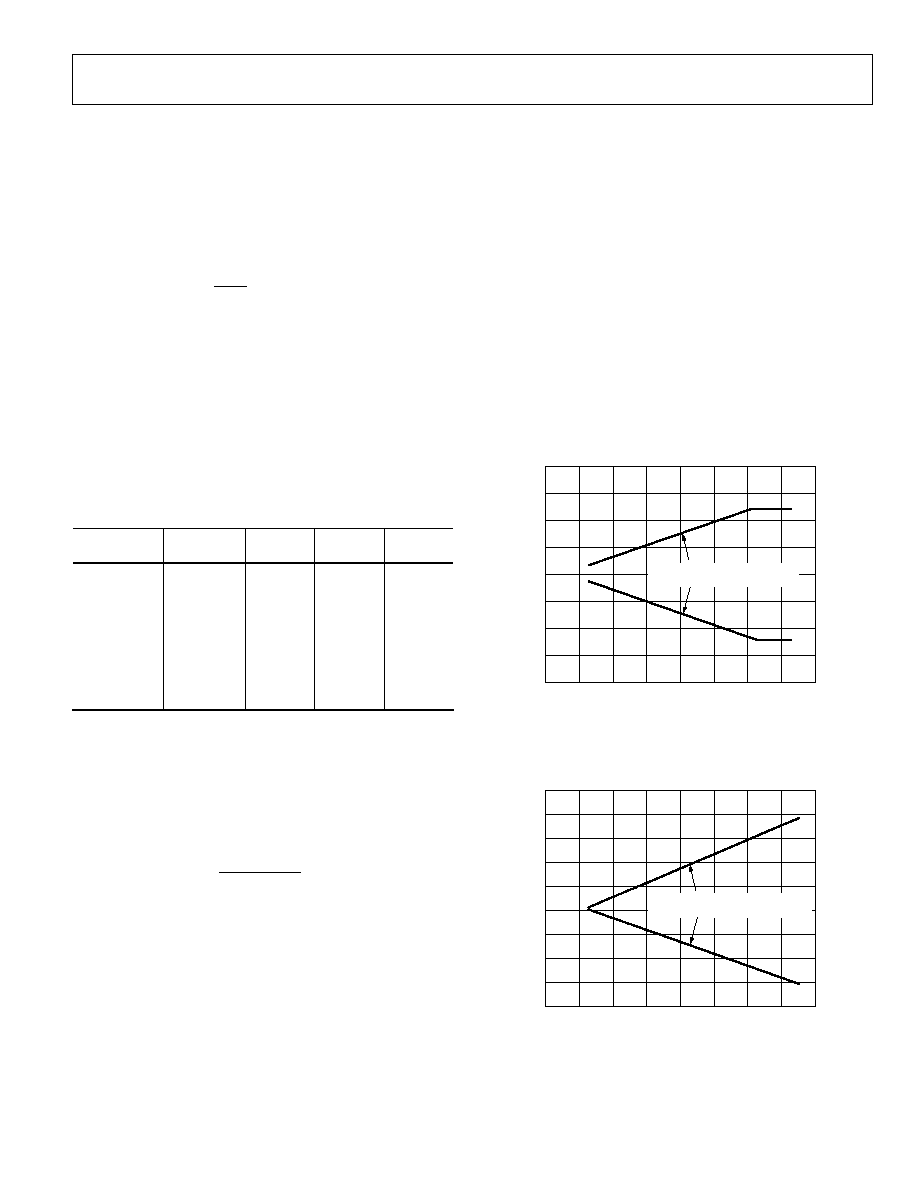
AD628
Rev. C | Page 15 of 20
APPLICATIONS
GAIN ADJUSTMENT
The AD628 system gain is provided by an architecture
consisting of two amplifiers. The gain of the input stage
is fixed at 0.1; the output buffer is user adjustable as
G
A2
= 1 + R
EXT1
/R
EXT2
. The system gain is then
+
◊
=
EXT2
EXT1
TOTAL
R
R
G
1
1
.
0
(1)
At a 2 nA maximum, the input bias current of the buffer amplifier
is very low and any offset voltage induced at the buffer amplifier by
its bias current may be neglected (2 nA ◊ 10 k = 20 µV). However,
to absolutely minimize bias current effects, R
EXT1
and R
EXT2
may be
selected so that their parallel combination is 10 k. If practical
resistor values force the parallel combination of R
EXT1
and R
EXT2
below 10 k, a series resistor (R
EXT3
) may be added to make up for
the difference. Table 5 lists several values of gain and corresponding
resistor values.
Table 5. Nearest Standard 1% Resistor Values for Various
Gains (See Figure 29)
Total Gain
(V/V)
A2 Gain
(V/V)
R
EXT1
()
R
EXT2
()
R
EXT3
()
0.1 1 10
k
0
0.2
2
20 k
20 k
0
0.25
2.5
25.9 k
18.7 k
0
0.5
5
49.9 k
12.4 k
0
1
10
100 k
11 k
0
2
20
200 k
10.5 k
0
5
50
499 k
10.2 k
0
10
100
1 M
10.2 k
0
To set the system gain to less than 0.1, an attenuator may be
created by placing a resistor, R
EXT4
, from Pin 4 (C
FILT
) to the
reference voltage. A divider would be formed by the 10 k
resistor which is in series with the positive input of A2 and
R
EXT4
. A2 would be configured for unity gain.
Using a divider and setting A2 to unity gain yields
1
k
10
0.1
/
◊
+
◊
=
EXT4
EXT4
DIVIDER
W
R
R
G
INPUT VOLTAGE RANGE
The common-mode input voltage range is determined by V
REF
and the supply voltage. The relation is expressed by
REF
S
CM
REF
S
CM
V
V
V
V
V
UPPER
10
)
V
2
.
1
(
11
V
10
)
V
2
.
1
≠
(
11
LOWER
-
+
-
-
+
(2)
where
+
S
V
is the positive supply,
-
S
V
is the negative supply
and 1.2 V is the headroom needed for suitable performance.
Equation 2 provides a general formula for calculating the
common-mode input voltage range. However, the AD628
should be kept within the maximum limits listed in the
Specifications table (Table 1) to maintain optimal performance.
This is illustrated in Figure 30 where the maximum common-
mode input voltage is limited to ±120 V. Figure 31 shows the
common-mode input voltage bounds for single-supply voltages.
≠200
≠150
≠100
≠50
0
50
IN
PU
T C
O
M
M
ON
-
M
OD
E VOLTA
GE (
V
)
100
150
200
8
6
2
4
0
10
12
14
16
SUPPLY VOLTAGE (±V)
02992-C-035
MAXIMUM INPUT COMMON-MODE
VOLTAGE WHEN V
REF
= GND
Figure 30. Input Common-Mode Voltage vs. Supply Voltage for Dual Supplies
≠80
≠60
≠40
≠20
0
20
40
60
80
100
IN
PU
T C
O
M
M
ON
-
M
OD
E VOLTA
GE (
V
)
8
6
2
4
0
10
12
14
16
SINGLE-SUPPLY VOLTAGE (V)
02992-C-034
MAXIMUM INPUT COMMON-MODE
VOLTAGE WHEN V
REF
= MIDSUPPLY
Figure 31. Input Common-Mode Voltage vs.
Supply Voltage for Single Supplies

AD628
Rev. C | Page 16 of 20
The differential input voltage range is constrained to the
linear operation of the internal amplifiers A1 and A2. The
voltage applied to the inputs of A1 and A2 should be between
V
S-
+ 1.2 V and V
S+
- 1.2 V. Similarly, the outputs of A1 and A2
should be kept between V
S
-
+ 0.9 V and V
S+
- 0.9 V.
VOLTAGE LEVEL CONVERSION
Industrial signal conditioning and control applications typically
require connections between remote sensors or amplifiers and
centrally located control modules. Signal conditioners provide
output voltages up to ±10 V full scale; however, ADCs or
microprocessors operating on single 3.3 V to 5 V logic supplies
are becoming the norm. Thus, the controller voltages require
further reduction in amplitude and reference.
Furthermore, voltage potentials between locations are seldom
compatible, and power line peaks and surges can generate
destructive energy between utility grids. The AD628 is an ideal
solution to both problems. It attenuates otherwise destructive
signal voltage peaks and surges by a factor of 10 and shifts the
differential input signal to the desired output voltage.
Conversion from voltage-driven or current-loop systems is
easily accommodated using the circuit in Figure 32. This shows
a circuit for converting inputs of various polarities and
amplitudes to the input of a single-supply ADC.
Note that the common-mode output voltage can be adjusted by
connecting Pin 3 (V
REF
) and the lower end of the 10 k resistor
to the desired voltage. The output common-mode voltage will
be the same as the reference voltage.
The design of such an application may be done in a few simple
steps, which include the following:
∑
Determine the required gain. For example, if the input voltage
must be transformed from ±10 V to 0 V to +5 V, the gain is
+5/+20 or +0.25.
∑
Determine if the circuit common-mode voltage must be
changed. An AD7715-5 ADC is illustrated for this example.
When operating from a 5 V supply, the common-mode
voltage of the AD7715 is half the supply or 2.5 V. If the
AD628 reference pin and the lower terminal of the 10 k
resistor are connected to a 2.5 V voltage source, the output
common-mode voltage will be 2.5 V.
Table 6 shows resistor and reference values for commonly used
single-supply converter voltages. R
EXT3
is included as an option.
It is used to balance the source impedance into A2, which is
described in more detail in the Gain Adjustment section.
Table 6. Nearest 1% Resistor Values for Voltages Level
Conversion Applications
Input
Voltage
(V)
ADC
Supply
Voltage
(V)
Desired
Output
Voltage (V)
V
REF
(V)
R
EXT1
(k)
R
EXT3
(k)
±10 5
2.5
2.5
15.0
4.02
±5 5
2.5
2.5
39.7
2.00
+10 5
2.5
2.5
39.7
2.00
+5 5
2.5
2.5
89.8
1.00
±10 3
1.25
1.25
2.49
7.96
±5 3
1.25
1.25
15.0
4.02
+10 3
1.25
1.25
15.0
4.02
+5 3
1.25
1.25
39.7
2.00
100k
≠IN
AD628
+V
S
+IN
≠V
S
V
REF
+IN
≠IN
A1
100k
10k
C
FILT
V
IN
(SEE
TABLE 5)
10k
10k
+IN
≠IN
A2
R
G
R
EXT3
(SEE
TABLE 5)
R
EXT1
OUT
10k
G = +0.1
(SEE
TABLE 5)
+5V
AD680
+5V
+5V
AD7715-5
SERIAL CLOCK
CLOCK
NC
+2.5V
SCLK
MCLK IN
MCLK OUT
CS
RESET
AV
DD
AIN(+)
AIN(≠)
DGND
DV
DD
DIN
DOUT
DRDY
AGND
REF IN(≠)
REF IN(+)
02992-C
-
030
Figure 32. Level Shifter
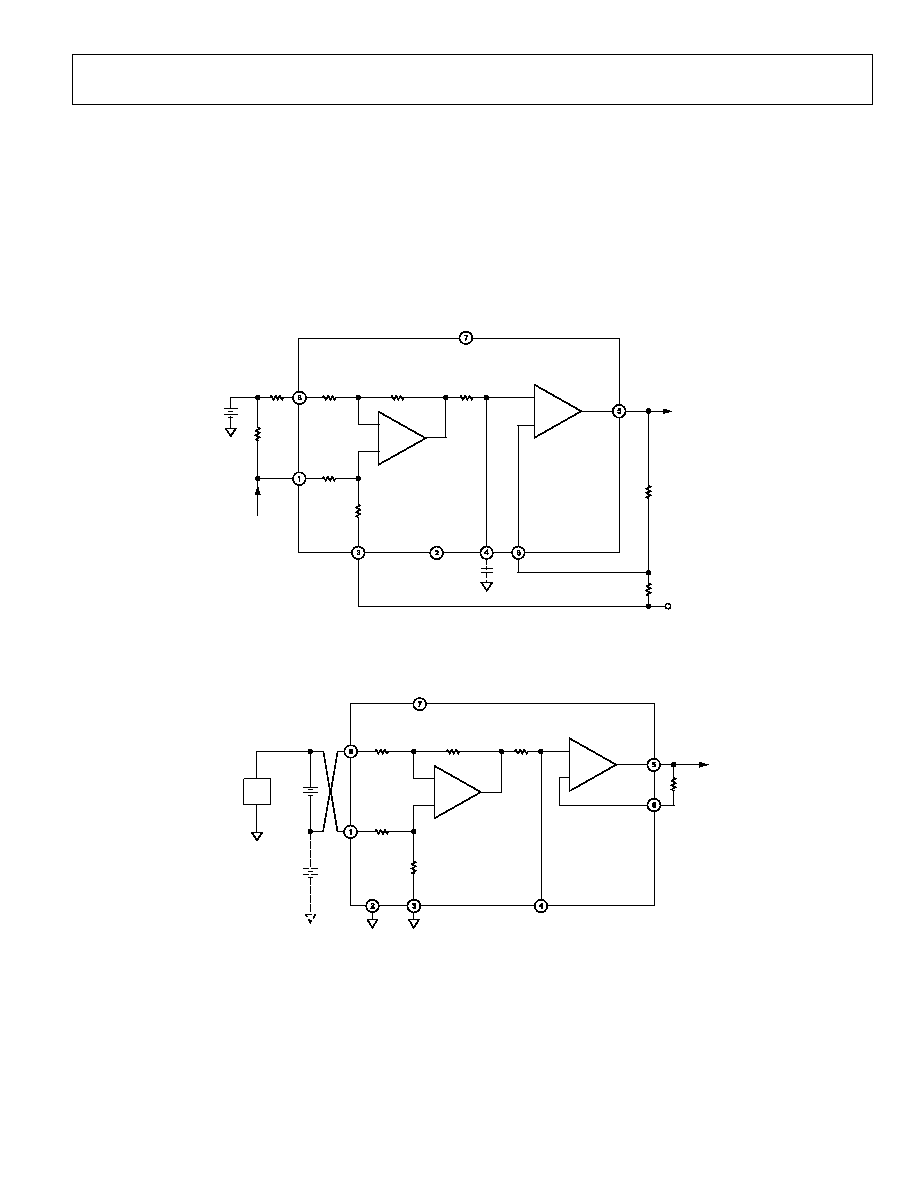
AD628
Rev. C | Page 17 of 20
CURRENT LOOP RECEIVER
Analog data transmitted on a 4 to 20 mA current loop may be
detected with the receiver shown in Figure 33. The AD628 is an
ideal choice for such a function, because the current loop must
be driven with a compliance voltage sufficient to stabilize the
loop, and the resultant common-mode voltage often exceeds
commonly used supply voltages. Note that with large shunt
values a resistance of equal value must be inserted in series with
the inverting input to compensate for an error at the
noninverting input.
MONITORING BATTERY VOLTAGES
Figure 34 illustrates how the AD628 may be used to monitor a
battery charger. Voltages approximately eight times the power
supply voltage may be applied to the input with no damage. The
resistor divider action is well suited for the measurement of
many power supply applications, such as those found in battery
chargers or similar equipment.
+IN
≠IN
G = +0.1
10k
10k
AD628
+IN
≠IN
A2
+V
S
OUT
≠IN
250
250
100k
A1
+15V
+IN
100k
C
FILT
≠V
S
≠15V
V
REF
10k
R
EXT2
11k
R
EXT1
100k
2.5V
REF
0V TO 5V
TO ADC
4≠20mA
SOURCE
R
G
02992-C-031
Figure 33. Level Shifter for 4 to 20 mA Current Loop
+IN
≠IN
G = +0.1
10k
A1
≠IN
100k
+V
S
5V
V
REF
≠V
S
+IN
≠IN
A2
OUT
AD628
100k
10k
OTHER
BATTERIES IN
CHARGING
CIRCUIT
CHARGING
CIRCUIT
+1.5V
BATTERY
10k
+IN
nV
BAT
(V)
R
EXT1
10k
0V TO 5V
TO ADC
C
FILT
R
G
02992-C-032
Figure 34. Battery Voltage Monitor

AD628
Rev. C | Page 18 of 20
FILTER CAPACITOR VALUES
A capacitor may be connected to Pin 4 (C
FILT
) to implement a
low-pass filter. The capacitor value is
( )
F
15.9/
t
f
C =
where f
t
is the desired 3 dB filter frequency.
Table 7 shows several frequencies and their closest standard
capacitor values.
Table 7. Capacitor Values for Various Filter Frequencies
Frequency (Hz) Capacitor Value (µF)
10
1.5
50
0.33
60
0.27
100
0.15
400
0.039
1 k
0.015
5 k
0.0033
10 k
0.0015
KELVIN CONNECTION
In certain applications, it may be desirable to connect the
inverting input of an amplifier to a remote reference point. This
eliminates errors resulting in circuit losses in interconnecting
wiring. The AD628 is particularly suited for this type of
connection. In Figure 35, a 10 k resistor is added in the
feedback to match the source impedance of A2, which is
described in more detail in the Gain Adjustment section.
+IN
≠IN
A2
+V
S
5V
≠IN
+IN
V
REF
OUT
CIRCUIT
LOSS
LOAD
+IN
≠IN
G = +0.1
A1
AD628
≠V
S
10k
10k
10k
100k
100k
V
S
/2
C
FILT
R
G
10k
02992-
C-
033
Figure 35. Kelvin Connection

AD628
Rev. C | Page 19 of 20
OUTLINE DIMENSIONS
0.80
0.60
0.40
8∞
0∞
4
8
5
4.90
BSC
PIN 1
0.65 BSC
3.00
BSC
SEATING
PLANE
0.15
0.00
0.38
0.22
1.10 MAX
3.00
BSC
COPLANARITY
0.10
0.23
0.08
COMPLIANT TO JEDEC STANDARDS MO-187AA
Figure 36. 8-Lead Mini Small Outline Package [MSOP]
(RM-8)
Dimensions shown in millimeters
0.25 (0.0098)
0.17 (0.0067)
1.27 (0.0500)
0.40 (0.0157)
0.50 (0.0196)
0.25 (0.0099)
◊
45∞
8∞
0∞
1.75 (0.0688)
1.35 (0.0532)
SEATING
PLANE
0.25 (0.0098)
0.10 (0.0040)
4
1
8
5
5.00 (0.1968)
4.80 (0.1890)
4.00 (0.1574)
3.80 (0.1497)
1.27 (0.0500)
BSC
6.20 (0.2440)
5.80 (0.2284)
0.51 (0.0201)
0.31 (0.0122)
COPLANARITY
0.10
CONTROLLING DIMENSIONS ARE IN MILLIMETERS; INCH DIMENSIONS
(IN PARENTHESES) ARE ROUNDED-OFF MILLIMETER EQUIVALENTS FOR
REFERENCE ONLY AND ARE NOT APPROPRIATE FOR USE IN DESIGN
COMPLIANT TO JEDEC STANDARDS MS-012AA
Figure 37. 8-Lead Standard Small Outline Package [SOIC] Narrow Body
(R-8)
Dimensions shown in millimeters and (inches)
ORDERING GUIDE
Model
Temperature Range
Description
Package Option
Branding
AD628AR
-40∞C to +85∞C
8-Lead SOIC
R-8
AD628AR-REEL
-40∞C to +85∞C
8-Lead SOIC 13" Reel
R-8
AD628AR-REEL7
-40∞C to +85∞C
8-Lead SOIC 7" Reel
R-8
AD628ARM
-40∞C to +85∞C
8-Lead MSOP
RM-8
JGA
AD628ARM-REEL
-40∞C to +85∞C
8-Lead MSOP 13" Reel
RM-8
JGA
AD628ARM-REEL7
-40∞C to +85∞C
8-Lead MSOP 7" Reel
RM-8
JGA
AD628-EVAL
Evaluation
Board

AD628
Rev. C | Page 20 of 20
NOTES
© 2004 Analog Devices, Inc. All rights reserved. Trademarks and
registered trademarks are the property of their respective owners.
C02992≠0≠4/04(C)



















